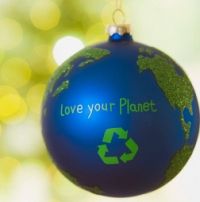

Every year at Christmas, the UK creates 30% more waste than usual, including an estimated 227,000 miles of wrapping paper and 114,000 tonnes of plastic packaging.
According to a survey by waste management company Biffa, a quarter of households predict they will throw away at least five bags of waste this Christmas, but 70% of Brits have said they will be upping their recycling efforts this festive season.
The research showed that the uplift in media mentions and public awareness regarding the climate emergency has had a noticeable impact on behaviour in the UK, with 65% citing it as a reason for their increased conscience this Christmas, and 40% said they felt guilty about how much waste their festivities will produce.
To try and minimise this guilt, Cedrec have considered some of the options to help you have a greener, more sustainable Christmas.
1. The tree
A yearly argument of comparing real and fake trees continues. One study concluded you would have to use a fake tree for 20 years for it to be greener, but seven million real trees will be dumped in January rather than recycled.
Look for opportunities to rent Christmas trees in your area; you rent and care for the tree over the Christmas period, then give it back for them to be replanted in January.
If renting a tree is not an option and you buy a tree, ensure it has been grown as locally as possible and check it has a Forest Stewardship Council (FSC) or Soil Association log. After Christmas go to the website recyclenow to find drop-off points in your area, where your tree will be recycled into chippings for local parks and woodland areas. Or take it to your local dump where you can add it to other green waste, or chop it up and stack the wood in your garden.
2. Lights and decorations
If every UK household swapped a string of incandescent lights for its LED equivalent, we could save more than £11 million and 29,000 tonnes of CO2, just over the 12 days of Christmas. LEDs are much more environmentally-friendly because they use up to 80% less energy.
Switch to solar-powered lights outdoors and if you can, set both on a timer to reduce your energy bills.
For decorations use baubles that you will use year after year, and look for designs made from brass, glass and wood. Or try hanging biscuits, gingerbread or sweets as an alternative.
Instead of tinsel try natural materials to decorate mantle pieces and bannisters, such as holly, ivy and pine cones. For the front door try making a plastic-free wreath using paper and twine.
3. Wrapping paper
Every year we use enough wrapping paper to stretch around the planet 9 times but what many of us do not realise is that many rolls contain non-recyclable elements like foil, glitter or plastic.
If you want to know if your wrapping paper can be recycled or not, use the scrunch test. Scrunch up the paper in your hands and then let it go, if the paper stays scrunched up then it can be recycled, if it unfolds by its own accord, then it likely contains non-recyclable elements.
Sustainable options include:
4. Christmas cards
Despite a quarter of us no longer writing Christmas Cards, for those that do there are greener ways to do so.
Look for cards made from recycled paper, that can be recycled, or that have the FSC mark which guarantees the paper has been produced sustainably and ethically. Plantable cards are growing in popularity too, such as seed packet cards that the recipient can sow in the spring.
You can recycle or compost your cards in January, or turn them into decorations for next year. You could also try making your own cards, or send an e-card!
5. Food
You could try cutting your dairy and meat intake to help make your Christmas more sustainable. Or try buying your meats and produce from small-scale producers such as local butchers, farms and grocery stalls. This will include fewer food miles, less packaging and less intense farming practices.
Also try eating the food in your freezer prior to Christmas to free up room for freezing leftovers instead of letting them go to waste. Anything you cannot freeze incorporate into a new dish, donate to a food bank or soup kitchen, or check if you are able to compost it.
6. Gifts
One of the best ways to make Christmas more sustainable is to re-think the way you give gifts. The best way to do this is to avoid the urge to get as many material gifts as possible and make sure to make every gift count.
For gifts you do buy look out for eco logos, such as Fairtrade, Rainforest Alliance, Scientific Certification Systems (SCS), FSC, Energy Star and Palm Oil Free.
Other options include:
7. Crackers and calendars
Replace single-use crackers that have plastic surprises with reusable ones. Some can be made with natural linen and allow you to add your own personal gifts.
Invest in a reusable advent calendar and fill it with a variety of homemade gifts and treats.